HSYP805: Disease Prevention and Health Promotion Program Evaluation
VerifiedAdded on 2023/04/03
|21
|2408
|241
Report
AI Summary
This report presents a comprehensive evaluation of a health promotion program designed to address the increasing prevalence of anxiety and depression disorders among adolescents in Australia. The program aims to promote mental health and a healthy workforce, focusing on socially and economically disadvantaged individuals. The evaluation plan incorporates process, impact, and outcome evaluations, utilizing various data sources such as program management records, surveys, and interviews to assess program implementation, reach, and effectiveness. Key evaluation questions address program delivery, participant satisfaction, and long-term impacts, with potential risks and mitigation strategies also outlined. The report includes a detailed sustainability plan, emphasizing education, reduced reliance on single funding sources, and pre and post-testing of data collection methods. The author reflects on the learning experience, highlighting the importance of community collaboration, effective communication, and interpersonal skills in promoting mental well-being and aims to contribute to a future where Australia is free from anxiety and depression disorders. The report also includes references and a logic model for the program.
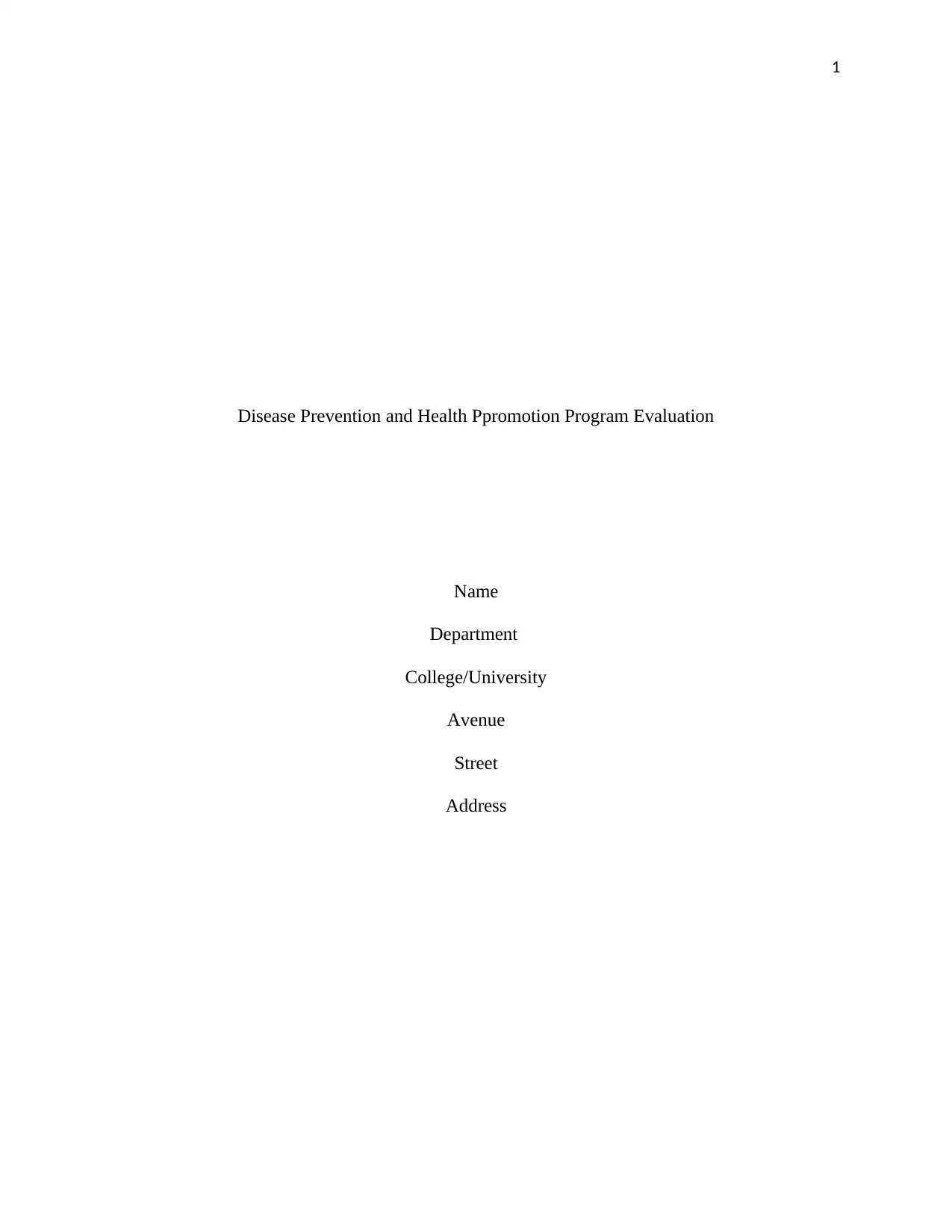
1
Disease Prevention and Health Ppromotion Program Evaluation
Name
Department
College/University
Avenue
Street
Address
Disease Prevention and Health Ppromotion Program Evaluation
Name
Department
College/University
Avenue
Street
Address
Paraphrase This Document
Need a fresh take? Get an instant paraphrase of this document with our AI Paraphraser
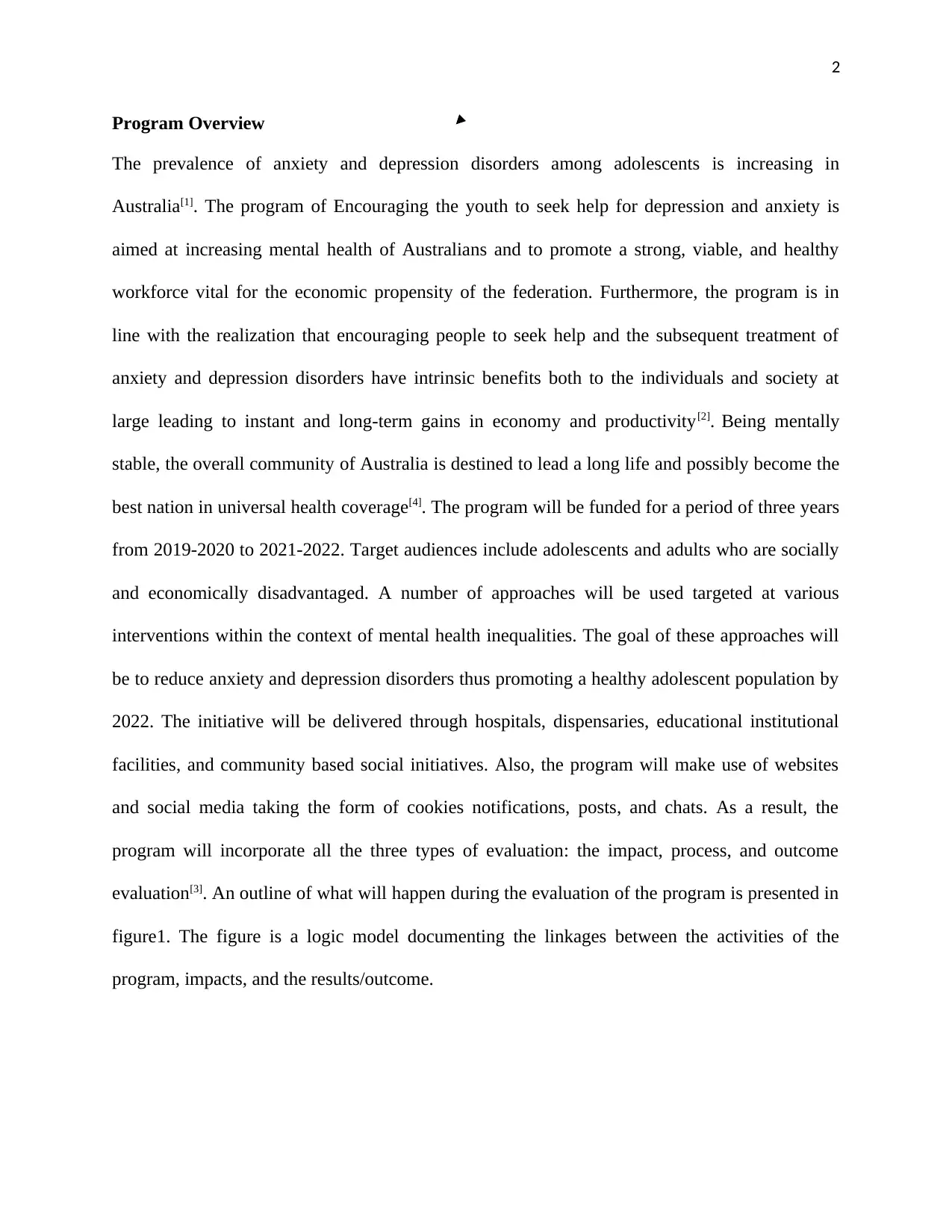
2
Program Overview
The prevalence of anxiety and depression disorders among adolescents is increasing in
Australia[1]. The program of Encouraging the youth to seek help for depression and anxiety is
aimed at increasing mental health of Australians and to promote a strong, viable, and healthy
workforce vital for the economic propensity of the federation. Furthermore, the program is in
line with the realization that encouraging people to seek help and the subsequent treatment of
anxiety and depression disorders have intrinsic benefits both to the individuals and society at
large leading to instant and long-term gains in economy and productivity[2]. Being mentally
stable, the overall community of Australia is destined to lead a long life and possibly become the
best nation in universal health coverage[4]. The program will be funded for a period of three years
from 2019-2020 to 2021-2022. Target audiences include adolescents and adults who are socially
and economically disadvantaged. A number of approaches will be used targeted at various
interventions within the context of mental health inequalities. The goal of these approaches will
be to reduce anxiety and depression disorders thus promoting a healthy adolescent population by
2022. The initiative will be delivered through hospitals, dispensaries, educational institutional
facilities, and community based social initiatives. Also, the program will make use of websites
and social media taking the form of cookies notifications, posts, and chats. As a result, the
program will incorporate all the three types of evaluation: the impact, process, and outcome
evaluation[3]. An outline of what will happen during the evaluation of the program is presented in
figure1. The figure is a logic model documenting the linkages between the activities of the
program, impacts, and the results/outcome.
Program Overview
The prevalence of anxiety and depression disorders among adolescents is increasing in
Australia[1]. The program of Encouraging the youth to seek help for depression and anxiety is
aimed at increasing mental health of Australians and to promote a strong, viable, and healthy
workforce vital for the economic propensity of the federation. Furthermore, the program is in
line with the realization that encouraging people to seek help and the subsequent treatment of
anxiety and depression disorders have intrinsic benefits both to the individuals and society at
large leading to instant and long-term gains in economy and productivity[2]. Being mentally
stable, the overall community of Australia is destined to lead a long life and possibly become the
best nation in universal health coverage[4]. The program will be funded for a period of three years
from 2019-2020 to 2021-2022. Target audiences include adolescents and adults who are socially
and economically disadvantaged. A number of approaches will be used targeted at various
interventions within the context of mental health inequalities. The goal of these approaches will
be to reduce anxiety and depression disorders thus promoting a healthy adolescent population by
2022. The initiative will be delivered through hospitals, dispensaries, educational institutional
facilities, and community based social initiatives. Also, the program will make use of websites
and social media taking the form of cookies notifications, posts, and chats. As a result, the
program will incorporate all the three types of evaluation: the impact, process, and outcome
evaluation[3]. An outline of what will happen during the evaluation of the program is presented in
figure1. The figure is a logic model documenting the linkages between the activities of the
program, impacts, and the results/outcome.
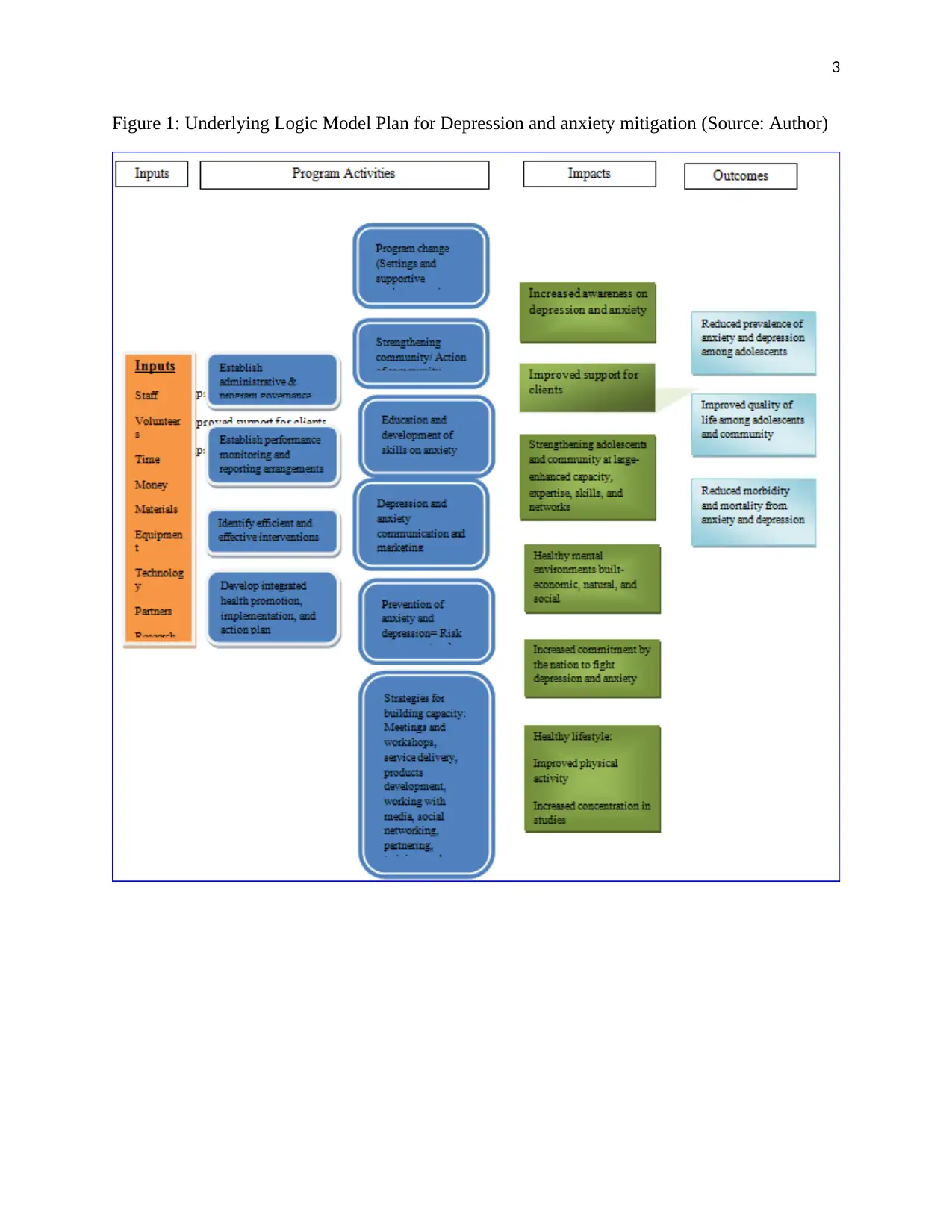
3
Figure 1: Underlying Logic Model Plan for Depression and anxiety mitigation (Source: Author)
Figure 1: Underlying Logic Model Plan for Depression and anxiety mitigation (Source: Author)
⊘ This is a preview!⊘
Do you want full access?
Subscribe today to unlock all pages.

Trusted by 1+ million students worldwide
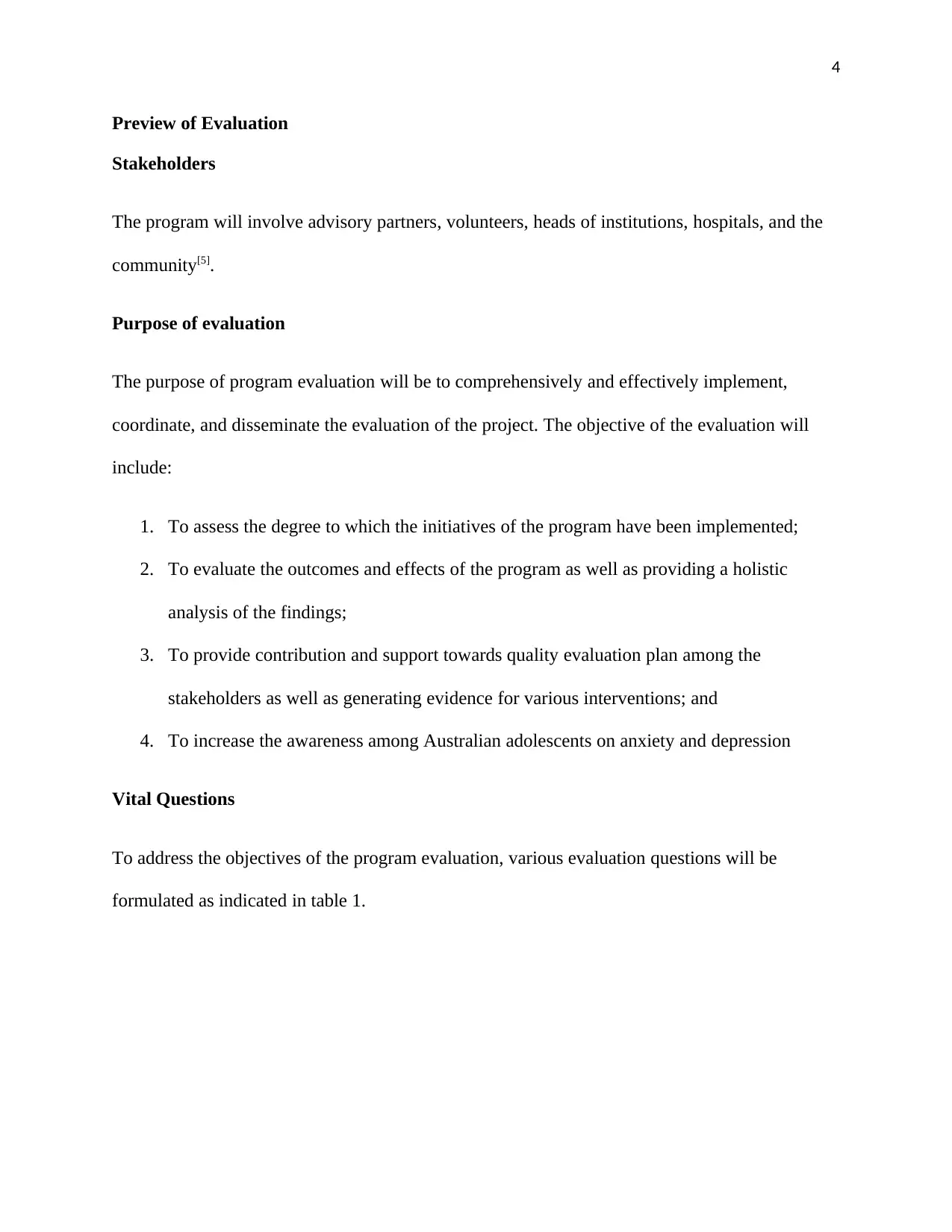
4
Preview of Evaluation
Stakeholders
The program will involve advisory partners, volunteers, heads of institutions, hospitals, and the
community[5].
Purpose of evaluation
The purpose of program evaluation will be to comprehensively and effectively implement,
coordinate, and disseminate the evaluation of the project. The objective of the evaluation will
include:
1. To assess the degree to which the initiatives of the program have been implemented;
2. To evaluate the outcomes and effects of the program as well as providing a holistic
analysis of the findings;
3. To provide contribution and support towards quality evaluation plan among the
stakeholders as well as generating evidence for various interventions; and
4. To increase the awareness among Australian adolescents on anxiety and depression
Vital Questions
To address the objectives of the program evaluation, various evaluation questions will be
formulated as indicated in table 1.
Preview of Evaluation
Stakeholders
The program will involve advisory partners, volunteers, heads of institutions, hospitals, and the
community[5].
Purpose of evaluation
The purpose of program evaluation will be to comprehensively and effectively implement,
coordinate, and disseminate the evaluation of the project. The objective of the evaluation will
include:
1. To assess the degree to which the initiatives of the program have been implemented;
2. To evaluate the outcomes and effects of the program as well as providing a holistic
analysis of the findings;
3. To provide contribution and support towards quality evaluation plan among the
stakeholders as well as generating evidence for various interventions; and
4. To increase the awareness among Australian adolescents on anxiety and depression
Vital Questions
To address the objectives of the program evaluation, various evaluation questions will be
formulated as indicated in table 1.
Paraphrase This Document
Need a fresh take? Get an instant paraphrase of this document with our AI Paraphraser
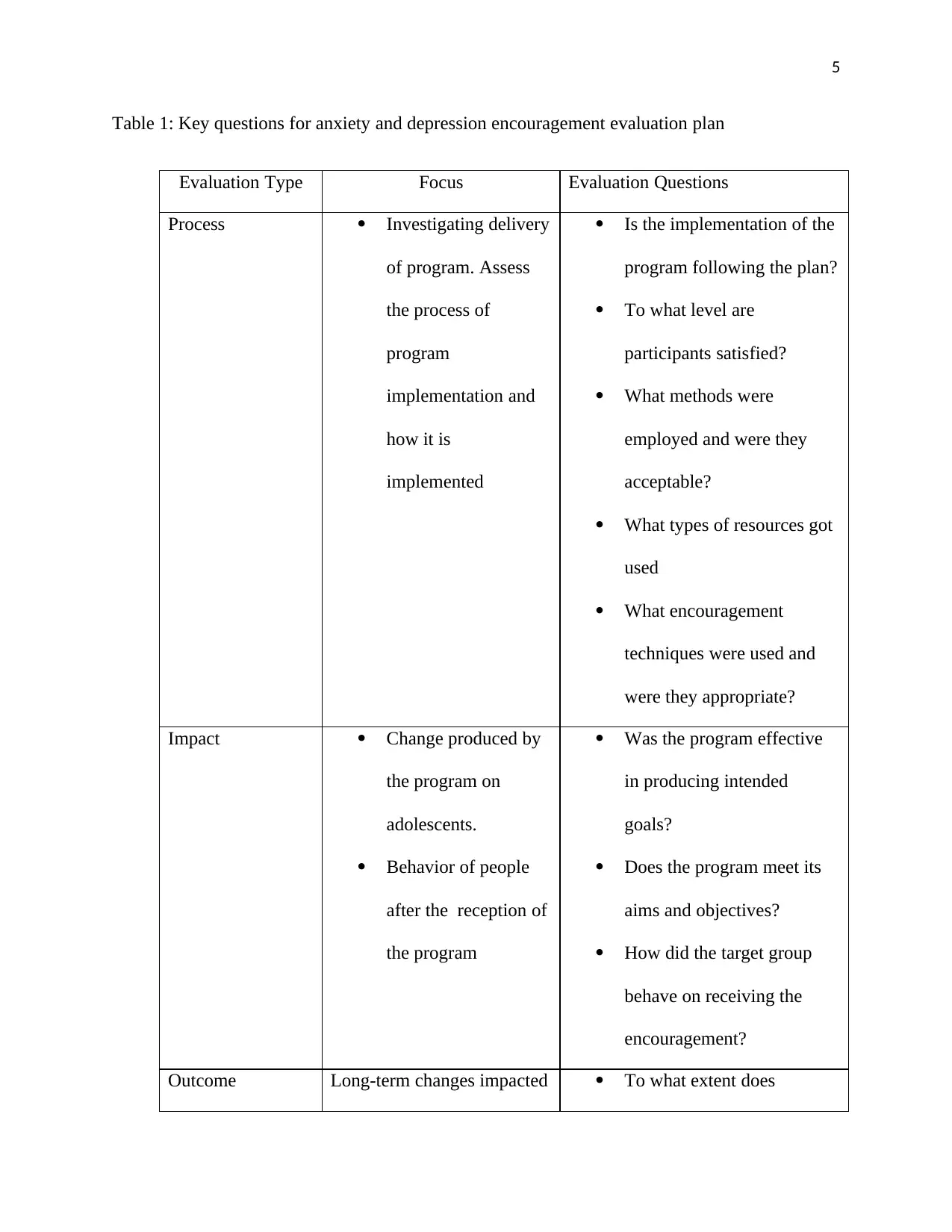
5
Table 1: Key questions for anxiety and depression encouragement evaluation plan
Evaluation Type Focus Evaluation Questions
Process Investigating delivery
of program. Assess
the process of
program
implementation and
how it is
implemented
Is the implementation of the
program following the plan?
To what level are
participants satisfied?
What methods were
employed and were they
acceptable?
What types of resources got
used
What encouragement
techniques were used and
were they appropriate?
Impact Change produced by
the program on
adolescents.
Behavior of people
after the reception of
the program
Was the program effective
in producing intended
goals?
Does the program meet its
aims and objectives?
How did the target group
behave on receiving the
encouragement?
Outcome Long-term changes impacted To what extent does
Table 1: Key questions for anxiety and depression encouragement evaluation plan
Evaluation Type Focus Evaluation Questions
Process Investigating delivery
of program. Assess
the process of
program
implementation and
how it is
implemented
Is the implementation of the
program following the plan?
To what level are
participants satisfied?
What methods were
employed and were they
acceptable?
What types of resources got
used
What encouragement
techniques were used and
were they appropriate?
Impact Change produced by
the program on
adolescents.
Behavior of people
after the reception of
the program
Was the program effective
in producing intended
goals?
Does the program meet its
aims and objectives?
How did the target group
behave on receiving the
encouragement?
Outcome Long-term changes impacted To what extent does
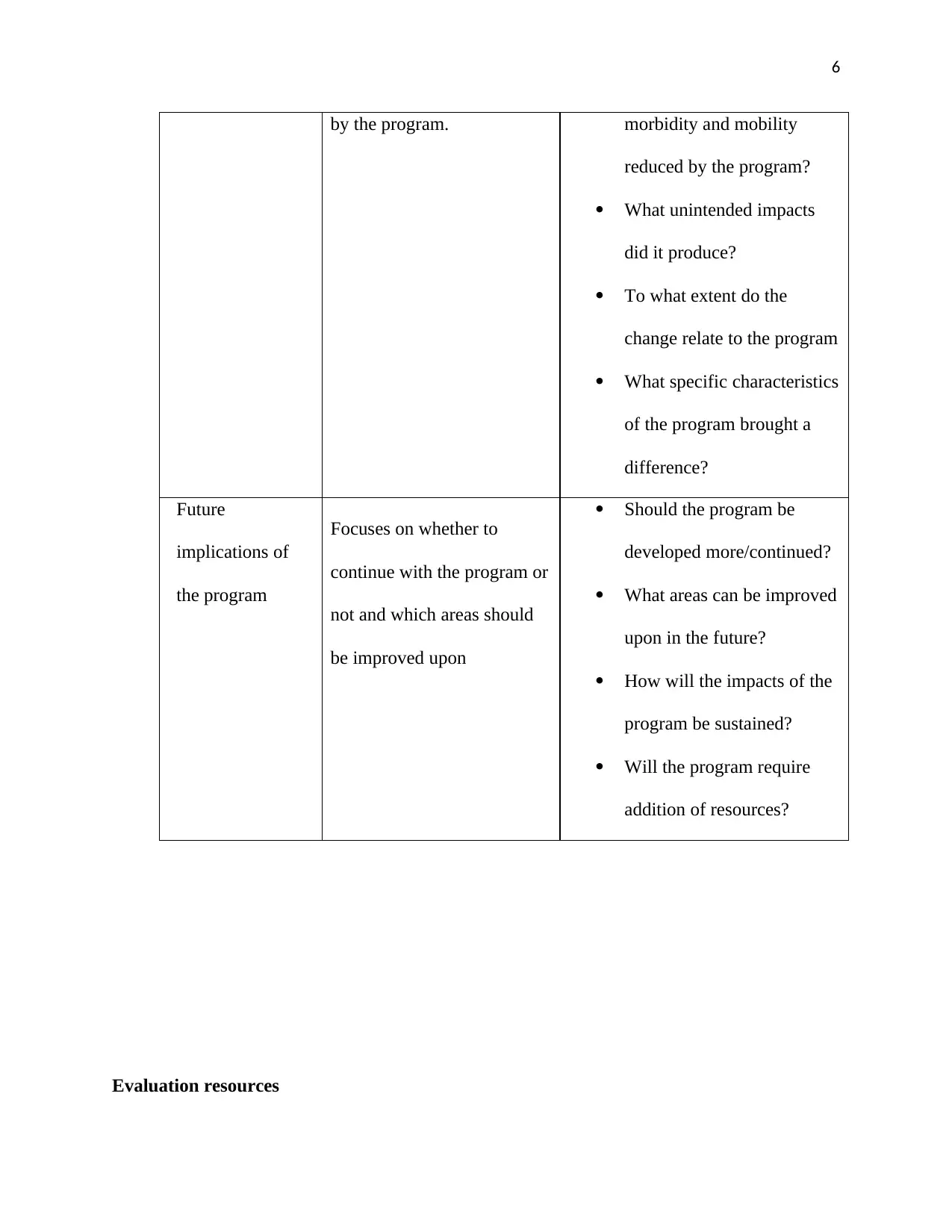
6
by the program. morbidity and mobility
reduced by the program?
What unintended impacts
did it produce?
To what extent do the
change relate to the program
What specific characteristics
of the program brought a
difference?
Future
implications of
the program
Focuses on whether to
continue with the program or
not and which areas should
be improved upon
Should the program be
developed more/continued?
What areas can be improved
upon in the future?
How will the impacts of the
program be sustained?
Will the program require
addition of resources?
Evaluation resources
by the program. morbidity and mobility
reduced by the program?
What unintended impacts
did it produce?
To what extent do the
change relate to the program
What specific characteristics
of the program brought a
difference?
Future
implications of
the program
Focuses on whether to
continue with the program or
not and which areas should
be improved upon
Should the program be
developed more/continued?
What areas can be improved
upon in the future?
How will the impacts of the
program be sustained?
Will the program require
addition of resources?
Evaluation resources
⊘ This is a preview!⊘
Do you want full access?
Subscribe today to unlock all pages.

Trusted by 1+ million students worldwide

7
There are various resources for funding the evaluation including economic resources, capital, and
political resources[7]: Below is a list of most important resources for the evaluation:
1. Funding from non-governmental organizations- this will be used for data collection and
impact evaluation
2. Mobilization from the state to ensure facilitation of various interventions so that impact
collection and outcome are realized.
3. Political resource providing the atmosphere and environment for program evaluation
Data Sources and Evaluation Design
The evaluation of the program will use two main evaluation methods: Impact/outcome
evaluation and process evaluation.
Process evaluation
The main process evaluation methods will be reviewed. Besides, the evaluation of important
documents will be done in order to assess the extent to which the program activities highlighted
in figure 1 are implemented. Also, data collected will be assessed in a bid to measure program
reach. Program reach refers to the number of key settings, stakeholders, community members,
and partners affected by the program[8]. Measuring of some reach aspects such as attendance of
program will be done at the outcome/impact evaluation. Furthermore, other aspects found at the
process evaluation constitute appropriateness and quality of the undertaken processes during
implementation.
Tools for data collection/sources of data for process evaluation
There are various resources for funding the evaluation including economic resources, capital, and
political resources[7]: Below is a list of most important resources for the evaluation:
1. Funding from non-governmental organizations- this will be used for data collection and
impact evaluation
2. Mobilization from the state to ensure facilitation of various interventions so that impact
collection and outcome are realized.
3. Political resource providing the atmosphere and environment for program evaluation
Data Sources and Evaluation Design
The evaluation of the program will use two main evaluation methods: Impact/outcome
evaluation and process evaluation.
Process evaluation
The main process evaluation methods will be reviewed. Besides, the evaluation of important
documents will be done in order to assess the extent to which the program activities highlighted
in figure 1 are implemented. Also, data collected will be assessed in a bid to measure program
reach. Program reach refers to the number of key settings, stakeholders, community members,
and partners affected by the program[8]. Measuring of some reach aspects such as attendance of
program will be done at the outcome/impact evaluation. Furthermore, other aspects found at the
process evaluation constitute appropriateness and quality of the undertaken processes during
implementation.
Tools for data collection/sources of data for process evaluation
Paraphrase This Document
Need a fresh take? Get an instant paraphrase of this document with our AI Paraphraser
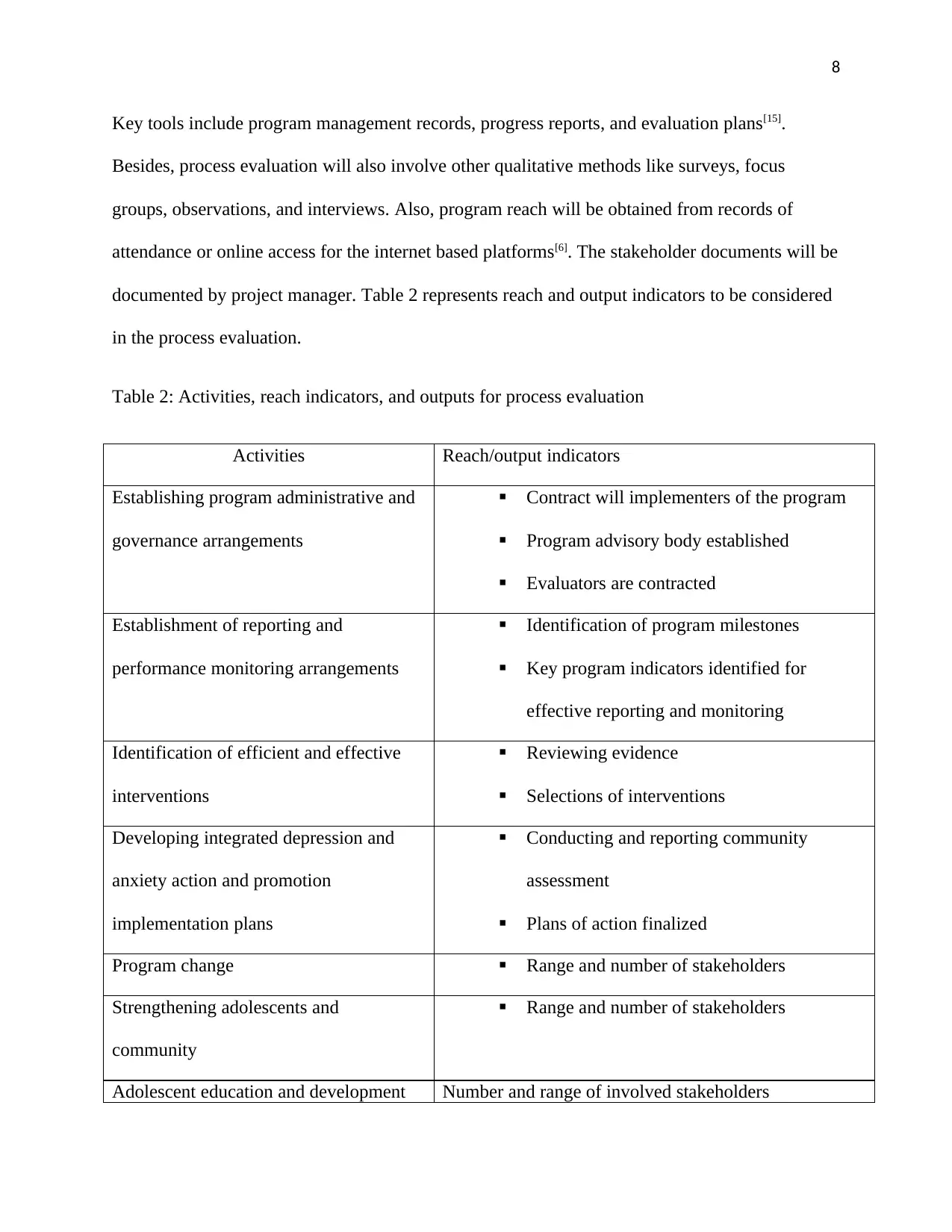
8
Key tools include program management records, progress reports, and evaluation plans[15].
Besides, process evaluation will also involve other qualitative methods like surveys, focus
groups, observations, and interviews. Also, program reach will be obtained from records of
attendance or online access for the internet based platforms[6]. The stakeholder documents will be
documented by project manager. Table 2 represents reach and output indicators to be considered
in the process evaluation.
Table 2: Activities, reach indicators, and outputs for process evaluation
Activities Reach/output indicators
Establishing program administrative and
governance arrangements
Contract will implementers of the program
Program advisory body established
Evaluators are contracted
Establishment of reporting and
performance monitoring arrangements
Identification of program milestones
Key program indicators identified for
effective reporting and monitoring
Identification of efficient and effective
interventions
Reviewing evidence
Selections of interventions
Developing integrated depression and
anxiety action and promotion
implementation plans
Conducting and reporting community
assessment
Plans of action finalized
Program change Range and number of stakeholders
Strengthening adolescents and
community
Range and number of stakeholders
Adolescent education and development Number and range of involved stakeholders
Key tools include program management records, progress reports, and evaluation plans[15].
Besides, process evaluation will also involve other qualitative methods like surveys, focus
groups, observations, and interviews. Also, program reach will be obtained from records of
attendance or online access for the internet based platforms[6]. The stakeholder documents will be
documented by project manager. Table 2 represents reach and output indicators to be considered
in the process evaluation.
Table 2: Activities, reach indicators, and outputs for process evaluation
Activities Reach/output indicators
Establishing program administrative and
governance arrangements
Contract will implementers of the program
Program advisory body established
Evaluators are contracted
Establishment of reporting and
performance monitoring arrangements
Identification of program milestones
Key program indicators identified for
effective reporting and monitoring
Identification of efficient and effective
interventions
Reviewing evidence
Selections of interventions
Developing integrated depression and
anxiety action and promotion
implementation plans
Conducting and reporting community
assessment
Plans of action finalized
Program change Range and number of stakeholders
Strengthening adolescents and
community
Range and number of stakeholders
Adolescent education and development Number and range of involved stakeholders
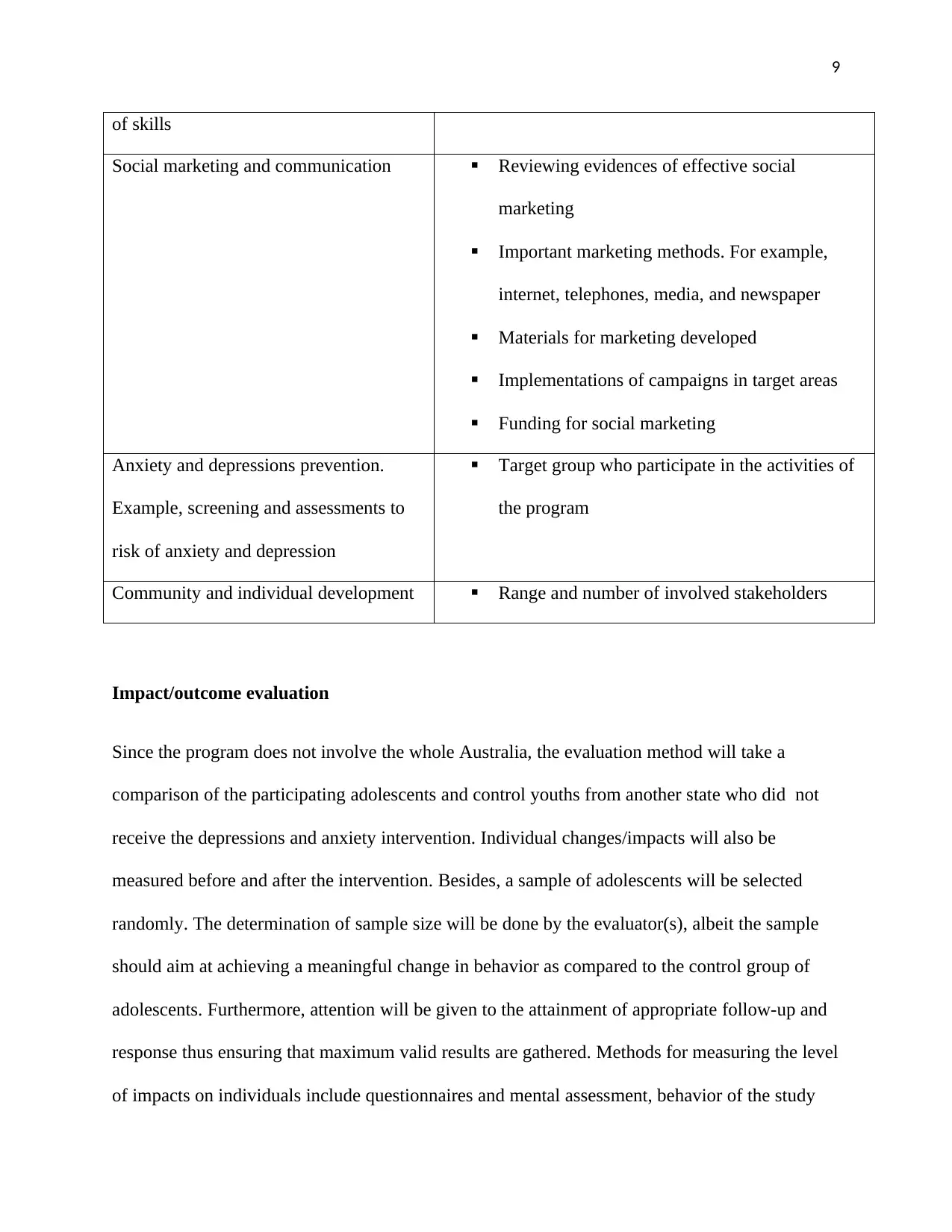
9
of skills
Social marketing and communication Reviewing evidences of effective social
marketing
Important marketing methods. For example,
internet, telephones, media, and newspaper
Materials for marketing developed
Implementations of campaigns in target areas
Funding for social marketing
Anxiety and depressions prevention.
Example, screening and assessments to
risk of anxiety and depression
Target group who participate in the activities of
the program
Community and individual development Range and number of involved stakeholders
Impact/outcome evaluation
Since the program does not involve the whole Australia, the evaluation method will take a
comparison of the participating adolescents and control youths from another state who did not
receive the depressions and anxiety intervention. Individual changes/impacts will also be
measured before and after the intervention. Besides, a sample of adolescents will be selected
randomly. The determination of sample size will be done by the evaluator(s), albeit the sample
should aim at achieving a meaningful change in behavior as compared to the control group of
adolescents. Furthermore, attention will be given to the attainment of appropriate follow-up and
response thus ensuring that maximum valid results are gathered. Methods for measuring the level
of impacts on individuals include questionnaires and mental assessment, behavior of the study
of skills
Social marketing and communication Reviewing evidences of effective social
marketing
Important marketing methods. For example,
internet, telephones, media, and newspaper
Materials for marketing developed
Implementations of campaigns in target areas
Funding for social marketing
Anxiety and depressions prevention.
Example, screening and assessments to
risk of anxiety and depression
Target group who participate in the activities of
the program
Community and individual development Range and number of involved stakeholders
Impact/outcome evaluation
Since the program does not involve the whole Australia, the evaluation method will take a
comparison of the participating adolescents and control youths from another state who did not
receive the depressions and anxiety intervention. Individual changes/impacts will also be
measured before and after the intervention. Besides, a sample of adolescents will be selected
randomly. The determination of sample size will be done by the evaluator(s), albeit the sample
should aim at achieving a meaningful change in behavior as compared to the control group of
adolescents. Furthermore, attention will be given to the attainment of appropriate follow-up and
response thus ensuring that maximum valid results are gathered. Methods for measuring the level
of impacts on individuals include questionnaires and mental assessment, behavior of the study
⊘ This is a preview!⊘
Do you want full access?
Subscribe today to unlock all pages.

Trusted by 1+ million students worldwide
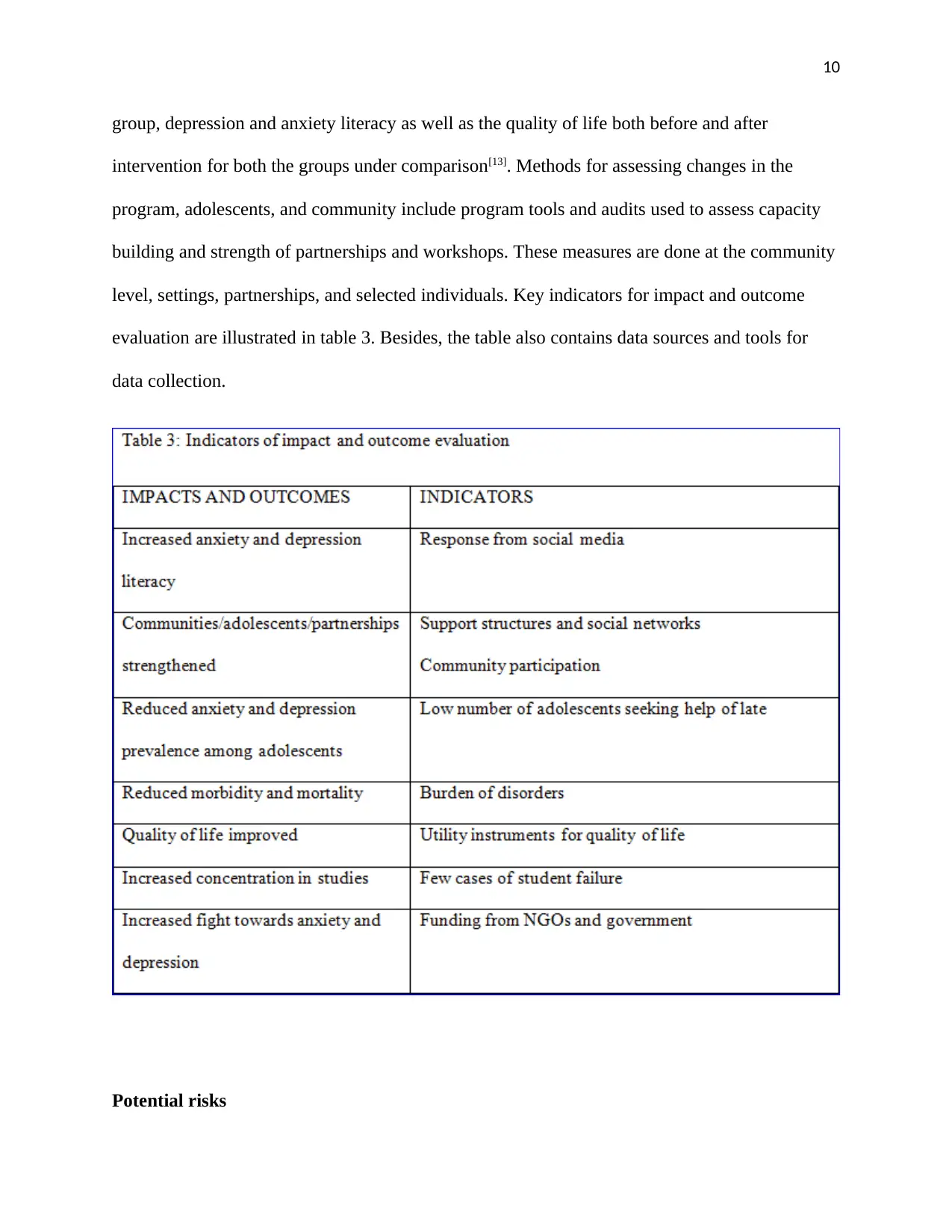
10
group, depression and anxiety literacy as well as the quality of life both before and after
intervention for both the groups under comparison[13]. Methods for assessing changes in the
program, adolescents, and community include program tools and audits used to assess capacity
building and strength of partnerships and workshops. These measures are done at the community
level, settings, partnerships, and selected individuals. Key indicators for impact and outcome
evaluation are illustrated in table 3. Besides, the table also contains data sources and tools for
data collection.
Potential risks
group, depression and anxiety literacy as well as the quality of life both before and after
intervention for both the groups under comparison[13]. Methods for assessing changes in the
program, adolescents, and community include program tools and audits used to assess capacity
building and strength of partnerships and workshops. These measures are done at the community
level, settings, partnerships, and selected individuals. Key indicators for impact and outcome
evaluation are illustrated in table 3. Besides, the table also contains data sources and tools for
data collection.
Potential risks
Paraphrase This Document
Need a fresh take? Get an instant paraphrase of this document with our AI Paraphraser
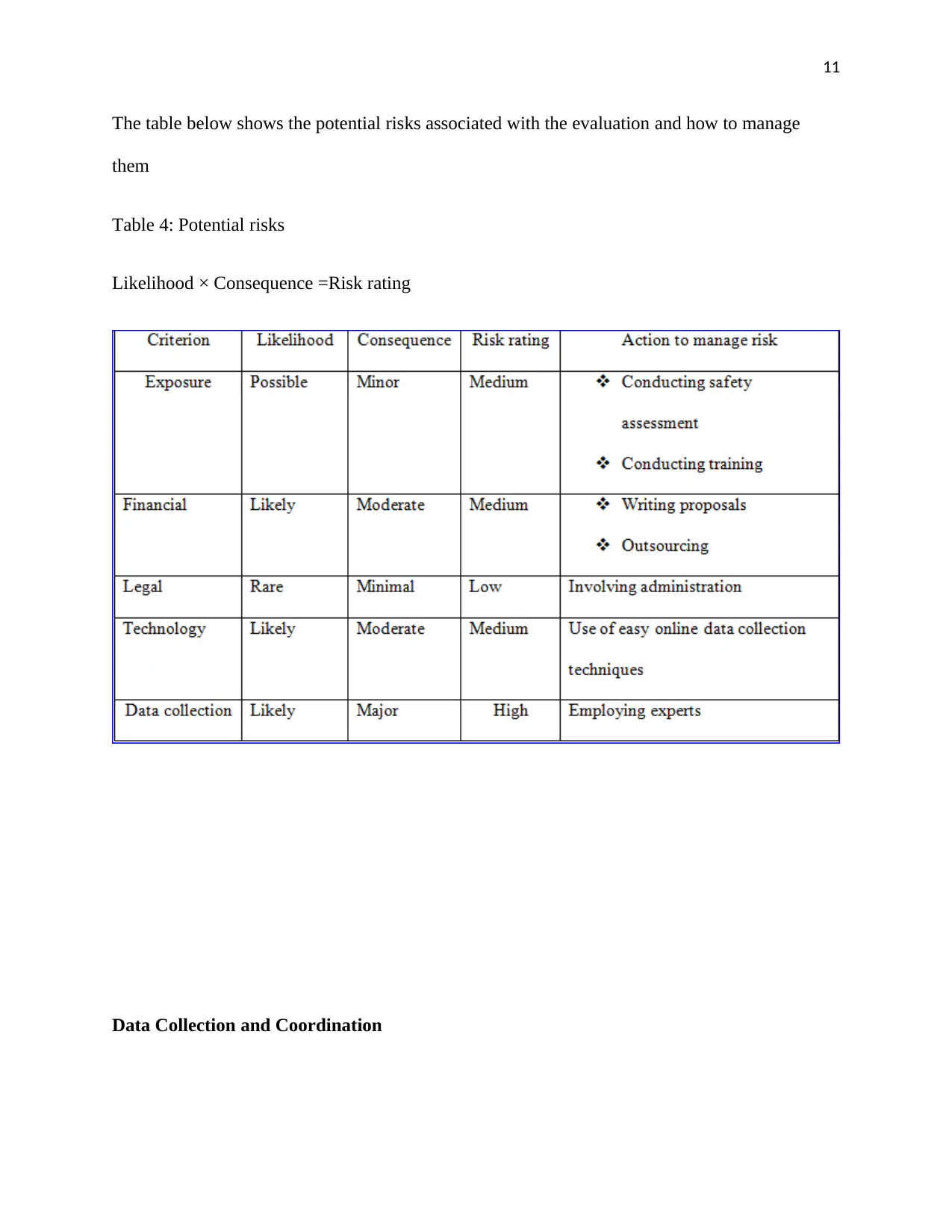
11
The table below shows the potential risks associated with the evaluation and how to manage
them
Table 4: Potential risks
Likelihood × Consequence =Risk rating
Data Collection and Coordination
The table below shows the potential risks associated with the evaluation and how to manage
them
Table 4: Potential risks
Likelihood × Consequence =Risk rating
Data Collection and Coordination
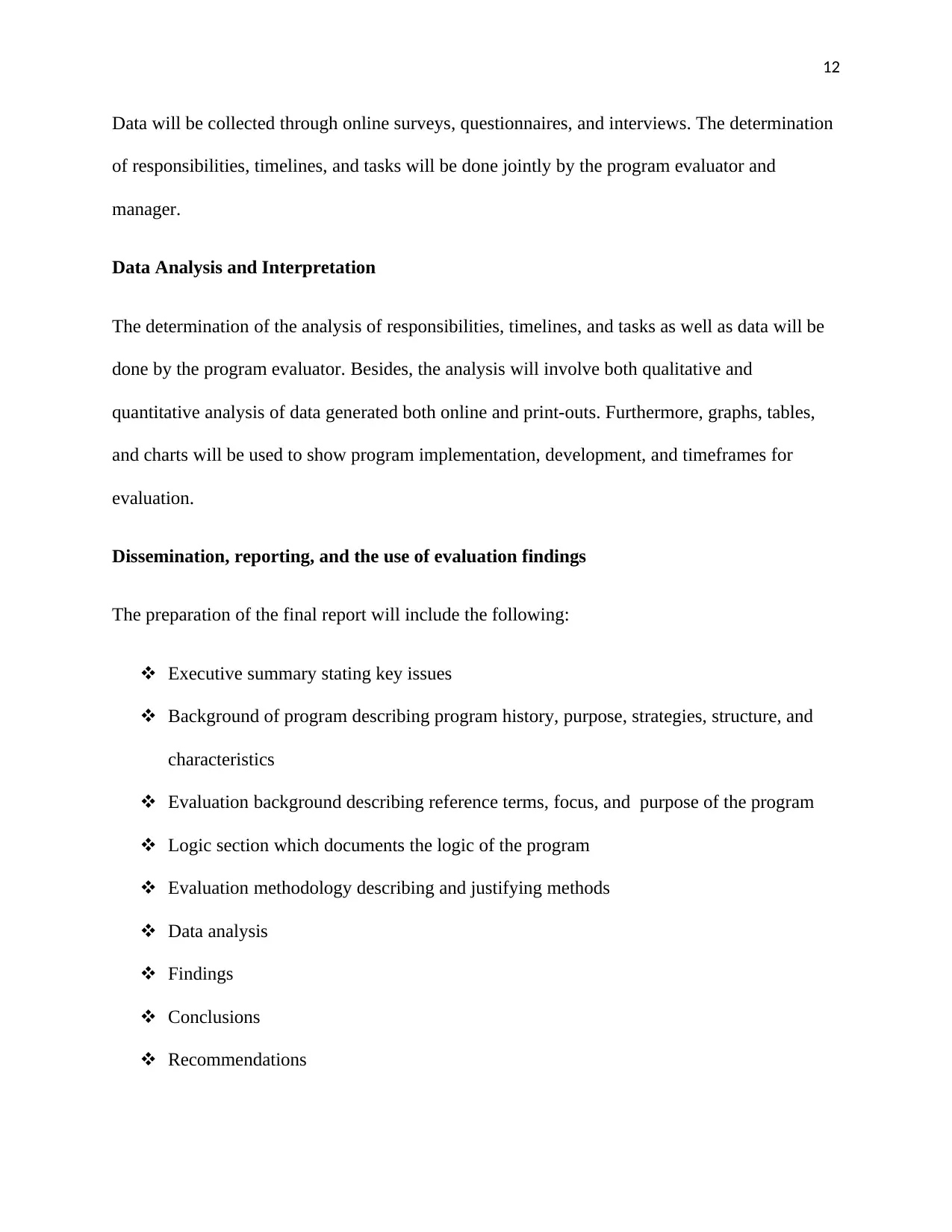
12
Data will be collected through online surveys, questionnaires, and interviews. The determination
of responsibilities, timelines, and tasks will be done jointly by the program evaluator and
manager.
Data Analysis and Interpretation
The determination of the analysis of responsibilities, timelines, and tasks as well as data will be
done by the program evaluator. Besides, the analysis will involve both qualitative and
quantitative analysis of data generated both online and print-outs. Furthermore, graphs, tables,
and charts will be used to show program implementation, development, and timeframes for
evaluation.
Dissemination, reporting, and the use of evaluation findings
The preparation of the final report will include the following:
Executive summary stating key issues
Background of program describing program history, purpose, strategies, structure, and
characteristics
Evaluation background describing reference terms, focus, and purpose of the program
Logic section which documents the logic of the program
Evaluation methodology describing and justifying methods
Data analysis
Findings
Conclusions
Recommendations
Data will be collected through online surveys, questionnaires, and interviews. The determination
of responsibilities, timelines, and tasks will be done jointly by the program evaluator and
manager.
Data Analysis and Interpretation
The determination of the analysis of responsibilities, timelines, and tasks as well as data will be
done by the program evaluator. Besides, the analysis will involve both qualitative and
quantitative analysis of data generated both online and print-outs. Furthermore, graphs, tables,
and charts will be used to show program implementation, development, and timeframes for
evaluation.
Dissemination, reporting, and the use of evaluation findings
The preparation of the final report will include the following:
Executive summary stating key issues
Background of program describing program history, purpose, strategies, structure, and
characteristics
Evaluation background describing reference terms, focus, and purpose of the program
Logic section which documents the logic of the program
Evaluation methodology describing and justifying methods
Data analysis
Findings
Conclusions
Recommendations
⊘ This is a preview!⊘
Do you want full access?
Subscribe today to unlock all pages.

Trusted by 1+ million students worldwide
1 out of 21
Related Documents
Your All-in-One AI-Powered Toolkit for Academic Success.
+13062052269
info@desklib.com
Available 24*7 on WhatsApp / Email
![[object Object]](/_next/static/media/star-bottom.7253800d.svg)
Unlock your academic potential
Copyright © 2020–2025 A2Z Services. All Rights Reserved. Developed and managed by ZUCOL.





